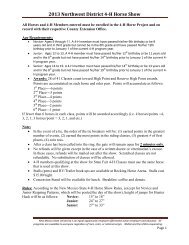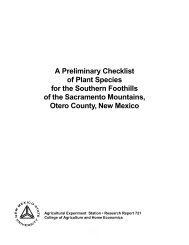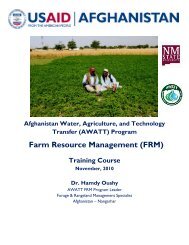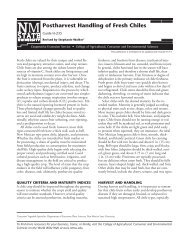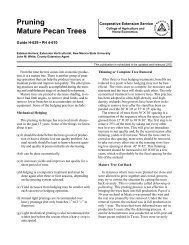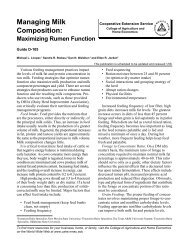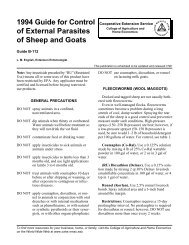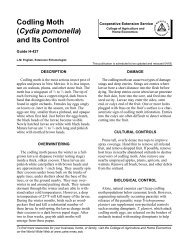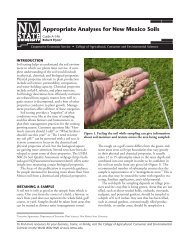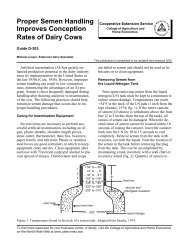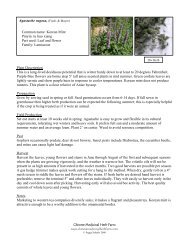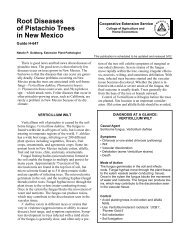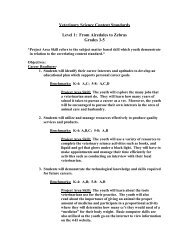The Reproductive Status of Your Dairy Herd - New Mexico State ...
The Reproductive Status of Your Dairy Herd - New Mexico State ...
The Reproductive Status of Your Dairy Herd - New Mexico State ...
You also want an ePaper? Increase the reach of your titles
YUMPU automatically turns print PDFs into web optimized ePapers that Google loves.
<strong>The</strong> <strong>Reproductive</strong><strong>Status</strong> <strong>of</strong><strong>Your</strong> <strong>Dairy</strong> <strong>Herd</strong>Cooperative Extension ServiceCollege <strong>of</strong> Agriculture andHome EconomicsGuide D-302John F. Smith, Extension <strong>Dairy</strong> Specialist andKim A. Becker, Extension 4-H Agent<strong>The</strong> reproductive status <strong>of</strong> a dairy herd has adramatic effect on a dairy's pr<strong>of</strong>itability andproduction. <strong>Reproductive</strong> problems can result inlong lactations, long dry periods, or possiblyboth, thus minimizing pr<strong>of</strong>its for the dairy producer.However, the reason these pr<strong>of</strong>its werelost may not be easily detected without properevaluation.<strong>The</strong> two most important management factorsrelating to reproductive performance are heatdetection and conception rates. Table 1 illustratesthe maximum average number <strong>of</strong> days betweencalving and first breeding for a cow herd tomaintain a 12.5-month calving interval undervarying levels <strong>of</strong> heat detection accuracy andconception rates.Table 1. Days from calving to first insemination tomaintain 12.5-month calving interval asaffected by heat detection accuracy (HDA) andconception rate.80 48 61 69 7670 41 54 64 7360 31 47 58 6850 16 36 51 6240 -36 29 37 52This publication is scheduled to be updated and reissued 8/99.DRY PERIOD LENGTHExceptionally long or short dry periods willadversely affect the pr<strong>of</strong>itability <strong>of</strong> individualcows. A short dry period will not provide adequaterest and time for mammary regeneration,while long dry periods will result in higher feedcosts with no income from milk production.Long dry periods can also result in fat cows thatare more prone to problems with health andreproductive performance. Each day dry over 60days costs $3. However, each day dry under 40days costs $2. Tables 2 and 3 show days dry inrelation to milk production.Table 2. Days dry related to milk production in the nextlactation (123,181 cows in 808 herds).Dry rangeMilk per cowdayslb90 15,86740 50 60 70% Conception rateEvaluation <strong>of</strong> complete and accurate breedingand heat detection records can assist the dairyproducer in achieving maximum reproductiveefficiency in the herd. <strong>The</strong> following eight factorsshould be considered by the producer to effectivelyevaluate the reproductive performance <strong>of</strong>the herd.Table 3. Days dry related to the difference in milk fromherdmates’ production in the next lactation(expressed as the difference in lactation milkproduction from herdmates; 281,816 cows).Difference fromDays dryherdmateslb40 +1450 +25360 +31570 +24780 +118
DAYS OPEN<strong>The</strong> number <strong>of</strong> days a cow is open (DO) maybe the best indicator <strong>of</strong> current reproductiveefficiency. A producer's goal is around 100 to110 DO. Excessive DO costs range from $2 to$5/cow/day for each day beyond 90 days open.For example, if a cow was open 120 days, shewould be open 30 excess days, a loss <strong>of</strong> $90/cow/year at $3/cow/day. Days open can be influencedby factors such as length <strong>of</strong> voluntary waitingperiod, heat detection accuracy, semen qualityand breeding technique, nutrition, cow fertility,disease, or weather.SERVICES PER CONCEPTION<strong>The</strong> number <strong>of</strong> services per conception (SC) isdirectly related to the conception rate in a herd.Conception rate influences days open because if acow does not conceive, she will be open anadditional estrous cycle (21 days). Each .1 over1.5 SC costs approximately $1.50. Cows with anadditional .5 SC cost $7.50 more per cow. Thismay not be a large amount per animal, but in aherd <strong>of</strong> 1000 cows the total could come to $7500per year. If problem breeders are not culled, SCwill continue to rise. Conception rate problemsmay be caused by heat detection accuracy, length<strong>of</strong> voluntary waiting period, semen handling,semen quality, time <strong>of</strong> insemination, inseminationtechniques, reproductive tract infection,nutritional status, fertility, or weather. Table 4shows the relationship between conception ratesand services per conception.HEATS DETECTEDHeat detection is a constant concern in dairyherds, as poor heat detection is one <strong>of</strong> the largestcontributors to a high days open value. If excessivedays open cost $2 to $5 dollars per day, asingle missed heat could cost $42 to $105 percow.DAYS IN MILK AT FIRST BREEDINGMost cows normally show their first estrus by30–50 days after calving. Recording these earlyheats will assist in identifying problem breeders.<strong>Dairy</strong> producers whose herds have good conceptionrates should set 65–70 days in milk at firstbreeding as their average goal.BREEDING INTERVALBreeding interval is a good indicator <strong>of</strong> howwell heats are being detected after the firstservice. <strong>Dairy</strong> producers should strive to maintainan average breeding interval <strong>of</strong> 25–30 days.Maintaining a breeding interval in this range willreduce costs associated with excessive days open.Use the following formula to calculate the averagedays between breedings after the first service:Breeding =days open -DIM at first breedinginterval services per cow -1Calculated breeding intervals are accurate only ifall breeding information is reported. Table 5demonstrates how increasing percentages <strong>of</strong>missed heats affect average breeding interval.Table 4. <strong>The</strong> relationship between conception rate andservices per conception.Conception Services perrateconception95–100 1.087–94 1.180–86 1.275–79 1.369–74 1.464–68 1.561–63 1.6Table 5. <strong>The</strong> relationship between heat detection rateand average breeding interval (ABI).ABI Heats detected Heats misseddays % %23 90 1026 80 2030 70 3035 60 4041 50 5050 40 6060 30 70Guide D-302 • Page 2
CALVING INTERVALCalving interval (CI) is the period between twoconsecutive calvings. It is affected by days openand gestation length. Average CI is a goodindicator <strong>of</strong> past reproductive performancebecause historical data is used to calculate the CI.However, calving interval may not be a goodindicator <strong>of</strong> the present reproductive status <strong>of</strong> theherd. CI cannot be calculated for cows removedfrom the herd because there is no later calvingdate to use as an end point for calculations;therefore, cows removed from the herd forreasons such as failure to conceive do not contributeto the herd's average CI value. Average CIshould be kept between 12 and 13 months. Table6 shows the losses associated with CIs over 12.6months. Table 7 shows the relationship betweenCI and average lactation milk yield.Table 6. Loss <strong>of</strong> returns to management associated withCIs over 12.6 months.CILoss per cowmonthsdollars12.6 0.0013.0 0.3613.3 14.6213.6 32.9614.0 57.5414.3 88.92AVERAGE DAYS IN MILKDays in milk (DIM) is related closely to dryperiod length and is a good indicator <strong>of</strong> reproductiveefficiency and herd management. <strong>The</strong> 12-month average for DIM should be 160–170 days.An average DIM greater than 200 indicates areproductive problem as a large DIM valueresults in a lower lifetime milk production percow due to long lactations and milking <strong>of</strong> latelactation cows. A short lactation reduces the lifetimemilk production because <strong>of</strong> long dry periods.SUMMARY<strong>The</strong>se variables will only be useful if accuraterecords are kept to determine whether a reproductiveproblem exists in the herd. <strong>The</strong>y can also beused to pinpoint the cause <strong>of</strong> poor performance.Using records effectively will allow a dairyproducer to set achievable goals for a herd.Lack <strong>of</strong> accurate reproductive records mayresult in hidden costs such as fewer calves, lowerconception rates, longer lactations and dry periods,poor identification <strong>of</strong> problem cows, and lostmilk production.REFERENCESAx, Roy, University <strong>of</strong> Arizona. Personal Communication1992.Table 7. Average lactation milk yield as related to lastcalving interval (795 herds, 121,773 cows).<strong>Herd</strong> average Rolling herdCI rangemilk averagemonths lb11.5–11.9 15,06212.0–12.4 17,42612.5–12.9 18,33013.0–13.4 18,49813.5–13.9 17,86414.0–14.4 17,73314.5–14.9 17,44015.0–15.4 15,99115.5–15.9 15,81416.0–16.4 14,884Grusenmeyer, D.C. and J.K. Hillers. 1989.Evaluating the dairy herd's reproductive status.National Cooperative <strong>Dairy</strong> <strong>Herd</strong> ImprovementProgram Handbook. Factsheet I-9.Grusenmeyer, D.C., J. Hillers and G. Williams.Evaluating dairy herd reproductive status usingDHI records. Western Regional ExtensionPublication#0067.O'Connor, M. Heat detection and timing <strong>of</strong> inseminationfor cattle. Pennsylvania <strong>State</strong>University Extension Circular 402.Guide D-302 • Page 3
<strong>New</strong> <strong>Mexico</strong> <strong>State</strong> University is an affirmative action/equal opportunity employer and educator. NMSU and the U.S. Department <strong>of</strong> Agriculturecooperating.September 1994 Las Cruces, NM1MGuide D-302 • Page 4



